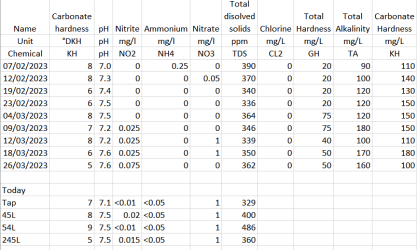TwoTankAmin
Fish Maniac
I think you should test the water in the smaller tanks. If there is a notable difference in the parameters between the small and the large, this may explain things. If the fish do fine in the small tanks and die in the big one, there has to be some difference between the two that is fatal. If nothing else it makes sense to rule this out as the potential cause of the problem.
As for copper pipes, old ones are safe but new ones not so. Over time the water builds up a coat on the copper which stops any leaching. A few year back we had some copper piping near the water tanks go bad and need to be replaced. Because I had so many fish which were pretty pricey, I did not take to the idea of replacing copper with copper. It was not a long stretch of pipe so I had them put in Pex which is an alternative to copper.
If there were white patches that could be columnaris. This is a bacterial disease which comes in multiple strains. Some are quite virulent and can wipe out a tank before any symptom are present. Other strains can be way less fatal and a fish can have these strains debilitating the fish but not killing them, at least not quickly, it can take a lot longer. The problem here is that any form of this disease requires antibiotic treatment. And one needs to medicate the entire tank when this is the confirmed problem.
However, there are other things that can create white patches on fish. One of the symprotms of columnaris gives it one of its common names, mouth fungus. You can see what looks to be fungus on the lips of the fish but it is not fungus. This disease is often called saddleback disease because fish often get a white patch at the base of their dorsal fin.
Again, the above is for your consideration as a possibility and not a firm diagnosis. Being able to rule it out eliminates abother possible cause.
Finally, if there is somthing toxic in the tank of which we cannot be aware beyond the fact that the fish keep dying, it makes it difficult to know how to proceed. To remove a contaminant one needs to know what it is, if possible. Changing water may not be enough, even multiple times. While we tend to trust sellers to sell healthy fish and safe decor etc. This is not a guarantee.
There is no way that I can determine that will reveal of there is anything toxic in the tank water. Testing it would cost a fortune. We know it isn't anything in the nitrogen complex. Even that short burst of nitrite is very low and likely not the problem. And if it was, you would definitely see fish gasping at the surface.
As for copper pipes, old ones are safe but new ones not so. Over time the water builds up a coat on the copper which stops any leaching. A few year back we had some copper piping near the water tanks go bad and need to be replaced. Because I had so many fish which were pretty pricey, I did not take to the idea of replacing copper with copper. It was not a long stretch of pipe so I had them put in Pex which is an alternative to copper.
If there were white patches that could be columnaris. This is a bacterial disease which comes in multiple strains. Some are quite virulent and can wipe out a tank before any symptom are present. Other strains can be way less fatal and a fish can have these strains debilitating the fish but not killing them, at least not quickly, it can take a lot longer. The problem here is that any form of this disease requires antibiotic treatment. And one needs to medicate the entire tank when this is the confirmed problem.
However, there are other things that can create white patches on fish. One of the symprotms of columnaris gives it one of its common names, mouth fungus. You can see what looks to be fungus on the lips of the fish but it is not fungus. This disease is often called saddleback disease because fish often get a white patch at the base of their dorsal fin.
Again, the above is for your consideration as a possibility and not a firm diagnosis. Being able to rule it out eliminates abother possible cause.
Finally, if there is somthing toxic in the tank of which we cannot be aware beyond the fact that the fish keep dying, it makes it difficult to know how to proceed. To remove a contaminant one needs to know what it is, if possible. Changing water may not be enough, even multiple times. While we tend to trust sellers to sell healthy fish and safe decor etc. This is not a guarantee.
There is no way that I can determine that will reveal of there is anything toxic in the tank water. Testing it would cost a fortune. We know it isn't anything in the nitrogen complex. Even that short burst of nitrite is very low and likely not the problem. And if it was, you would definitely see fish gasping at the surface.




